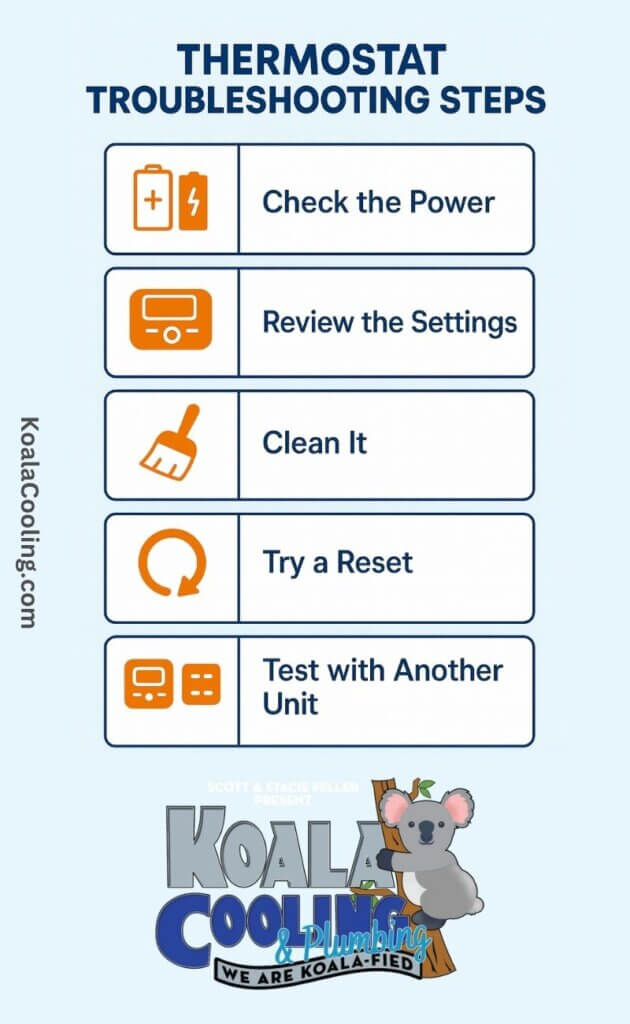Is your home feeling too hot or too cold even though your thermostat says otherwise? Your comfort might be suffering because your thermostat isn’t working like it should. While it’s easy to assume the HVAC system itself is the problem, sometimes the culprit is that small device on the wall: the thermostat.
When your thermostat starts to fail, it can cause your heating and cooling system to behave unpredictably, waste energy, or even stop working altogether. Because it’s often overlooked, many homeowners don’t realize there’s a problem until they’re uncomfortable or see an unexpectedly high energy bill.
Let’s walk through the telltale signs of a bad thermostat; basic troubleshooting tips, how to prevent future problems, and when it’s time to call in a professional for help.
What Does a Thermostat Do?
Your thermostat acts as the brain of your heating and cooling system. It monitors your home’s temperature and signals your HVAC system to run when temperatures rise or fall beyond your set comfort level. Without it, the system wouldn’t know when to operate.
There are several types of thermostats:
- Manual thermostats use dials or sliders and require manual adjustment.
- Programmable thermostats allow daily or weekly temperature schedules for greater efficiency.
- Smart thermostats connect to Wi-Fi and offer features like remote control, learning algorithms, and integration with smart home systems.
A malfunctioning thermostat can cause your HVAC system to short-cycle, run too long, or not operate at all, leading to discomfort and higher energy bills.
Signs Your Thermostat Is Failing
Here are some of the most common signs that your thermostat could be the issue rather than your HVAC system:
1. Inaccurate Temperature Readings
Does the room feel warmer or cooler than the displayed temperature? Faulty sensors can lead to incorrect readings and poor temperature regulation.
2. HVAC System Won’t Turn On or Off
If your system doesn’t start or continues running longer than it should, your thermostat might not be signaling the system properly.
3. Frequent Temperature Swings
Inconsistent temperature levels, where it’s comfortable one moment and freezing the next, can indicate a misfiring thermostat.
4. Blank or Unresponsive Display
A blank or frozen screen could be caused by dead batteries, a tripped circuit breaker, wiring issues, or internal faults.
5. Unexpected Energy Bill Spikes
A faulty thermostat can lead to inefficient system operation, driving up energy costs without noticeable comfort improvements.
6. Settings Keep Resetting
If your programmed settings vanish or your thermostat randomly changes modes, it may be suffering from internal malfunctions or power issues.
Troubleshooting Tips
Before assuming your thermostat needs replacement, try these simple checks:
1. Check the Power
Replace batteries if your unit uses them. For hardwired models, inspect the breaker box and wiring connections if safe to do so.
2. Review the Settings
Make sure your thermostat is set to the correct mode (heating or cooling) and that the setpoint is reasonable for the season.
3. Clean the Unit
Open the thermostat and gently remove any dust using a soft brush or canned air. Dust can interfere with temperature sensors.
4. Try a Reset
Some thermostats can be reset to clear software glitches. Refer to the manufacturer’s instructions for guidance.
5. Test Another Thermostat
If available, try using a different thermostat temporarily to see if the issue persists. If the replacement works, the original unit is likely faulty.

When to Call a Professional
If basic troubleshooting doesn’t resolve the issue, or if you’re uncomfortable handling electrical components, call a professional HVAC technician.
At Koala Cooling, our licensed technicians can:
- Inspect and test your thermostat and wiring
- Evaluate your HVAC system for related issues
- Recommend affordable repair or replacement options
- Expertly install and configure smart thermostats
We proudly serve homeowners throughout the Austin area with transparent pricing, honest advice, and reliable service.
Preventing Thermostat Problems
You can extend the life of your thermostat and reduce the risk of issues with a few preventative steps:
- Replace batteries every 6 to 12 months if your thermostat isn’t hardwired
- Keep it clean to prevent dust interference
- Avoid bad installation spots like direct sunlight or drafty areas
- Schedule regular HVAC maintenance so your technician can inspect the thermostat along with the rest of your system
Final Thoughts
Your thermostat plays a critical role in home comfort and energy efficiency. Ignoring signs of trouble can lead to unnecessary discomfort and expenses.
If your system isn’t behaving as expected and you’ve ruled out the obvious, the thermostat might be the source of the problem. Fortunately, identifying and fixing thermostat issues is often straightforward, especially with help from a trusted local professional. Need help diagnosing a thermostat problem? Contact us today. We’re here for homeowners across the Austin and Round Rock area with dependable HVAC support that keeps your home comfortable all year long.
